Sweden have been consistently recognised for having one of the strongest squads in women’s football. Since winning the European Championships in 1984, Sweden have mostly had to settle for being the ‘nearly’ team having finished as runners-up in the 1995 and 2001 Euros, the 2003 World Cup and silver medalists in the 2016 and 2020 Olympics.
Current manager Peter Gerhardsson has been in charge since Pia Sundhage’s departure in 2017 and will be looking to reach the final of this year’s tournament after 2019’s third-place finish. It’s no secret that Sweden have some incredibly talented players such as Fridolina Rolfö, who has already enjoyed huge success at club level after winning the Champions League with Barcelona.
For all their individual talents, it is Sweden’s performances as a team that are impressive under Gerhardsson, everyone seems to be singing off the same hymn sheet which makes them a force to be reckoned with on the international stage.
This tactical analysis which will take the form of a scout report will look into the tactics that we can expect from Sweden in the World Cup and provide an analysis of their style of play under Gerhardsson.
Predicted Starting XI
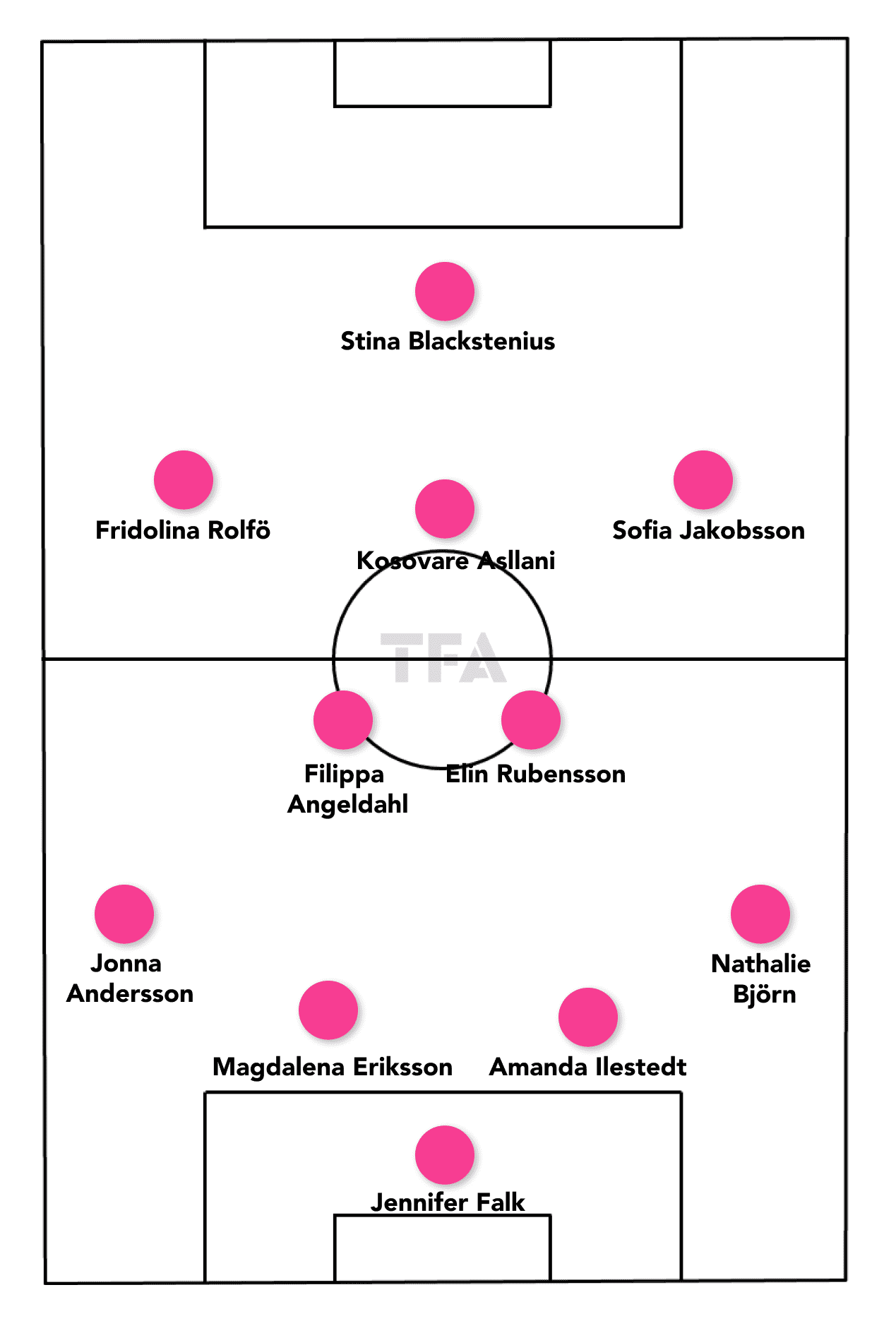
Throughout 2023, Gerhardsson has opted to use a 4-2-3-1 formation which suggests this is the system he may look to use in the World Cup. The starting goalkeeper position is still very much up for grabs between Jennifer Falk and Zećira Mušović as Gerhardsson has been rotating between the two for quite some time. For this predicted lineup, we have opted for Falk as she is slightly more experienced at international level but it is incredibly difficult to predict which goalkeeper will be given the nod.
We have opted for Nathalie Björn at right-back and Jonna Andersson at left-back as both have impressed in recent friendlies, Additionally, Magdalena Eriksson is all but guaranteed a place in the starting XI, her partner in central defence is difficult to predict but Amanda Ilestedt has plenty of experience and they would provide a solid defensive pairing.
Moving on to looking at the midfielders, it is likely that the vastly experienced Elin Rubensson will be given the nod. It wouldn’t be at all surprising to see Filippa Angeldahl starting as she has put in some wonderful performances at Manchester City this season. At 33, A.C. Milan’s Kosovare Asllani could potentially be playing in her last World Cup, her experience and unique skill set make her a great option to start in the number 10 role as she is able to link up so well with the midfield and attackers.
Speaking of the forward line, Barcelona’s Fridolina Rolfö is highly likely to start on the left wing for Sweden; the 29-year-old has enjoyed a successful season with the Catalan giants and will want to continue her recent good form into the World Cup. Sofia Jakobsson provides plenty of pace on the right wing which is very often utilised by this Sweden team as a way to shift the ball into the attacking third as quickly as possible. Finally, Stina Blackstenius stepped in to lead the line at Arsenal due to their injury crisis and as a result, scored 18 goals in 39 appearances which has pretty much cemented her place in this starting lineup.
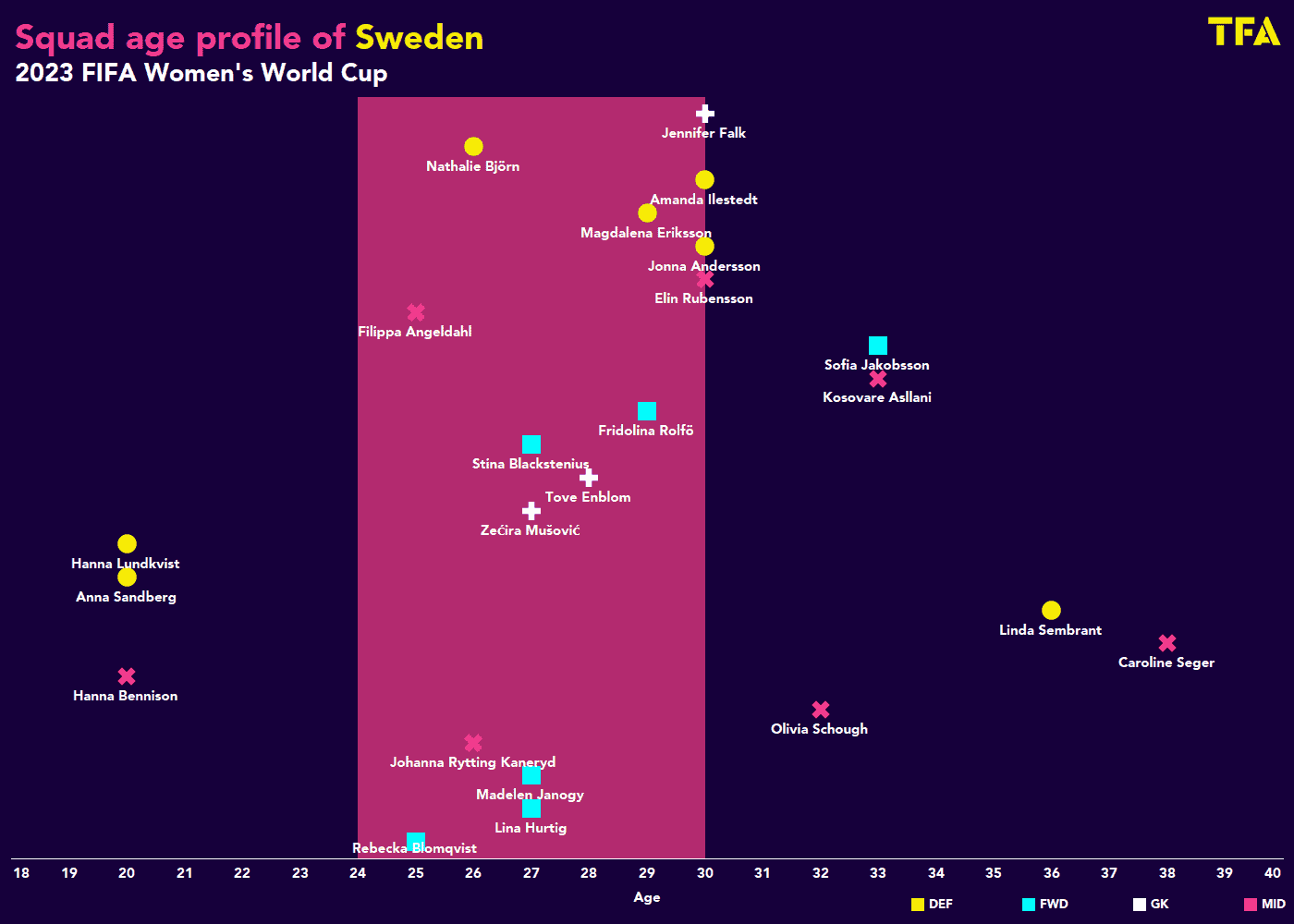
From the data visual above which showcases the team’s age range, we can see that this is a vastly experienced team with the majority of the team 25 and over, as well as a significant number of players over the age of 30. This could be a wise choice on Gerhardsson’s part as experienced players tend to possess a deeper understanding of tactical nuances and game management.
They have encountered different playing styles and strategies, both from their own past experiences and from facing various opponents. This experience enables them to read the game better, anticipate opponents’ moves, and make smarter decisions on the field which means they can provide valuable insights and leadership to their teammates, helping to maintain composure and execute effective game plans.
Attacking Phase
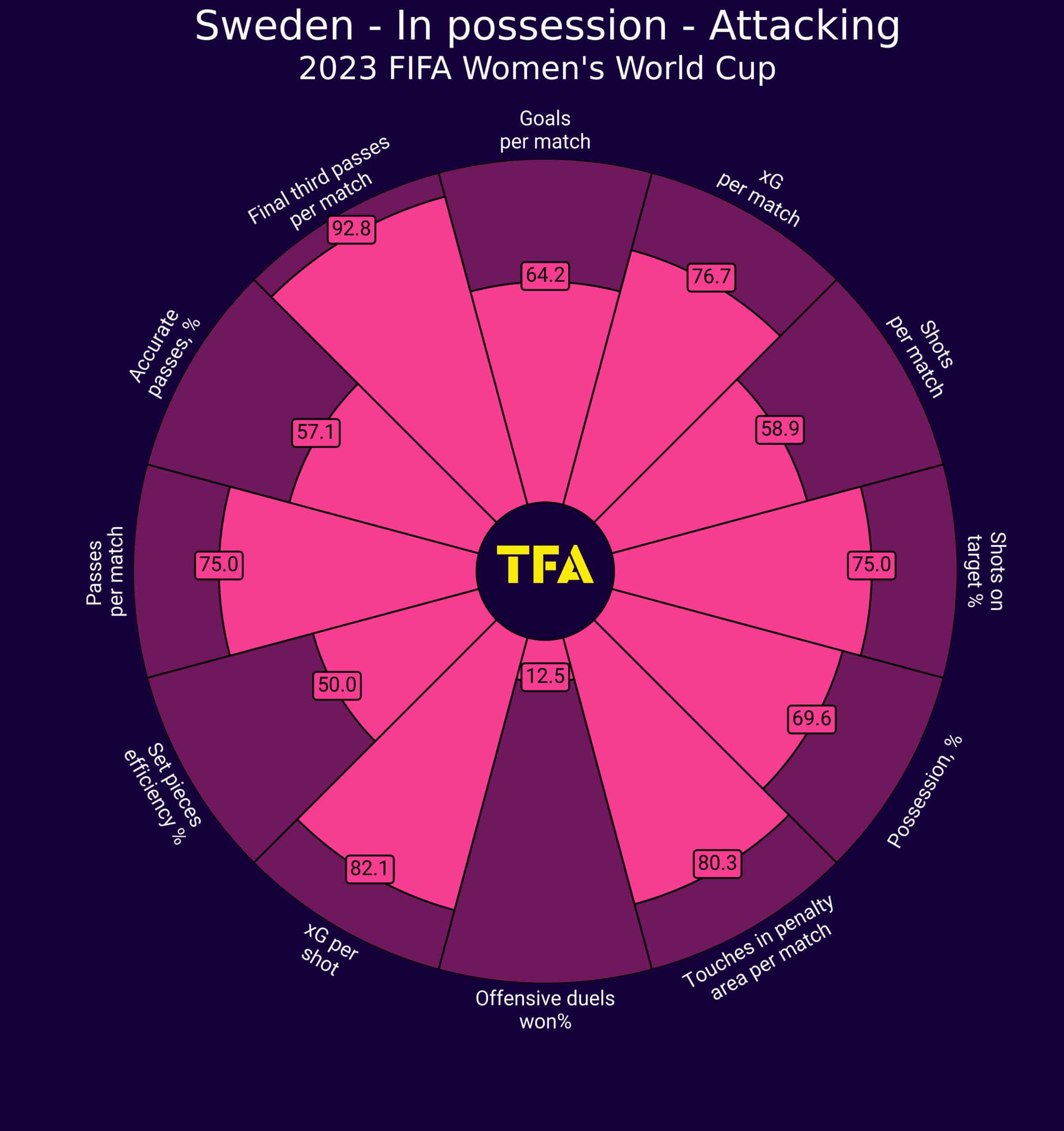
The visual above allows us to see how Sweden perform in the attacking phase. We can see they like to dominate possession and are very adept at creating goalscoring opportunities with the high amount of xG per shot on show. They have a high number of passes into the final third too which hints at their aggressiveness in trying to break the opposition down with penetrative passes. Interestingly, they are underperforming with the number of goals per game compared to the xG per game, perhaps they will need to be more clinical during this World Cup if they are looking to get to the final.
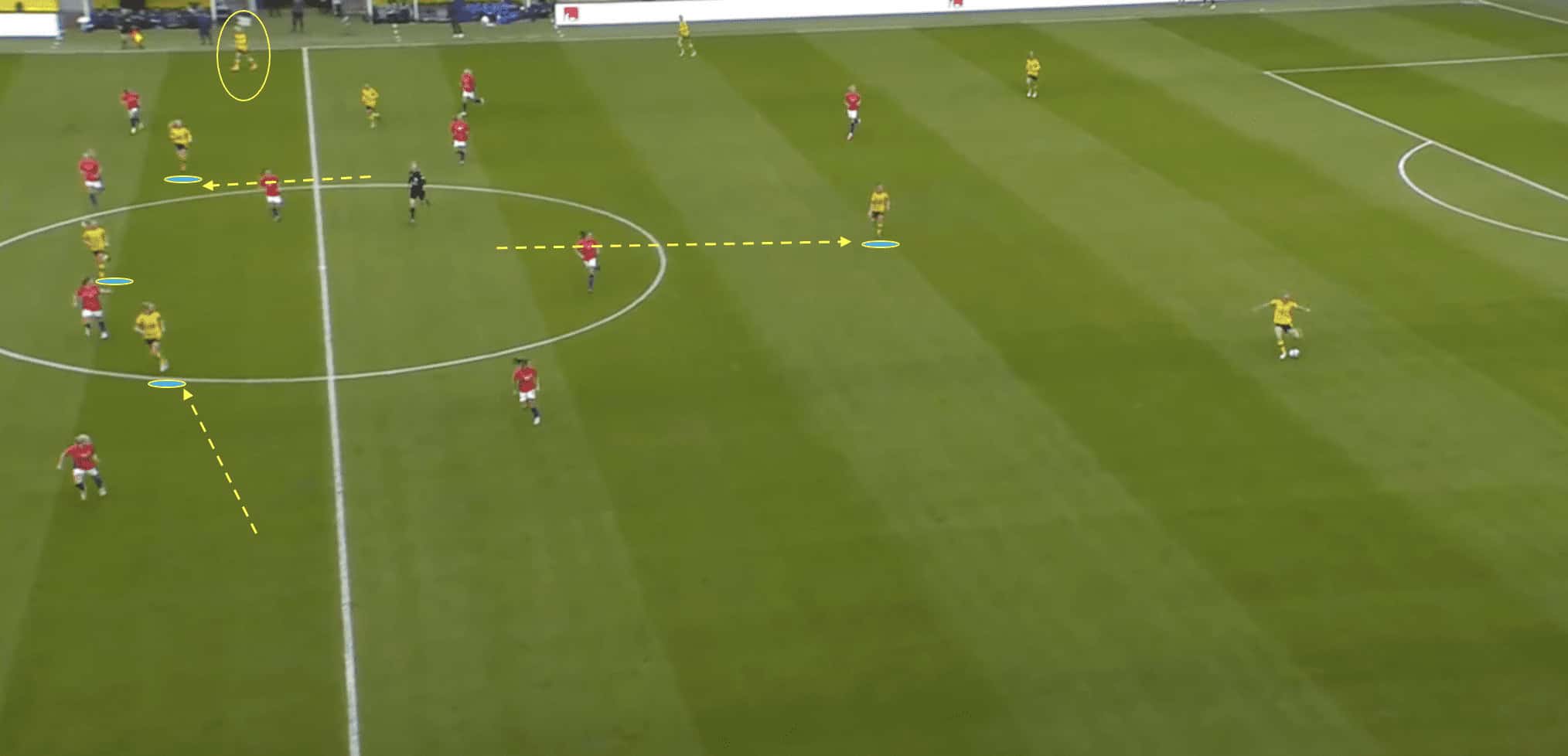
As discussed, Sweden typically favour a 4-2-3-1 formation which allows them to really overload the opposition defence when building an attack from the back. As we can see in the image above, Gerhardsson asks the two wide players and the attacking midfielder to push up higher to essentially form a front four. Typically, the right winger, Sofia Jakobsson, will stay wider whilst the left winger, Rolfö in this case, will sit narrower.
As a result of this, the central defenders will move out from a compact shape which allows the full-backs to push up higher, especially the left-back who has the space vacated by Rolfö to exploit. The responsibility is then on one of the midfielders to drop back to ensure she is able to fall back into a back three should Sweden lose possession.

Here, we can see that Sweden have matched the Norwegian backline player-for-player which means that they can take advantage of having a free player out wide on the right. In this specific scenario, Jakobsson has remained wide on the right whilst Angeldahl, one of the midfielders, has joined the attackers.
Matching the defensive line means that all four defenders are occupied and Sweden have the numerical advantage. This will help them to carve out goalscoring opportunities. For example, if the ball is worked out to Jakobsson and she is able to cross into the box, there are at least four Swedish players who could turn the ball goalwards.
Additionally, the Swedish attacking players can interchange positions, which will create confusion for the opposing defenders and make it difficult for them to mark specific players. This fluidity and positional interchangeability can lead to mismatches, gaps in the defence, and opportunities for through balls or crosses into the box.
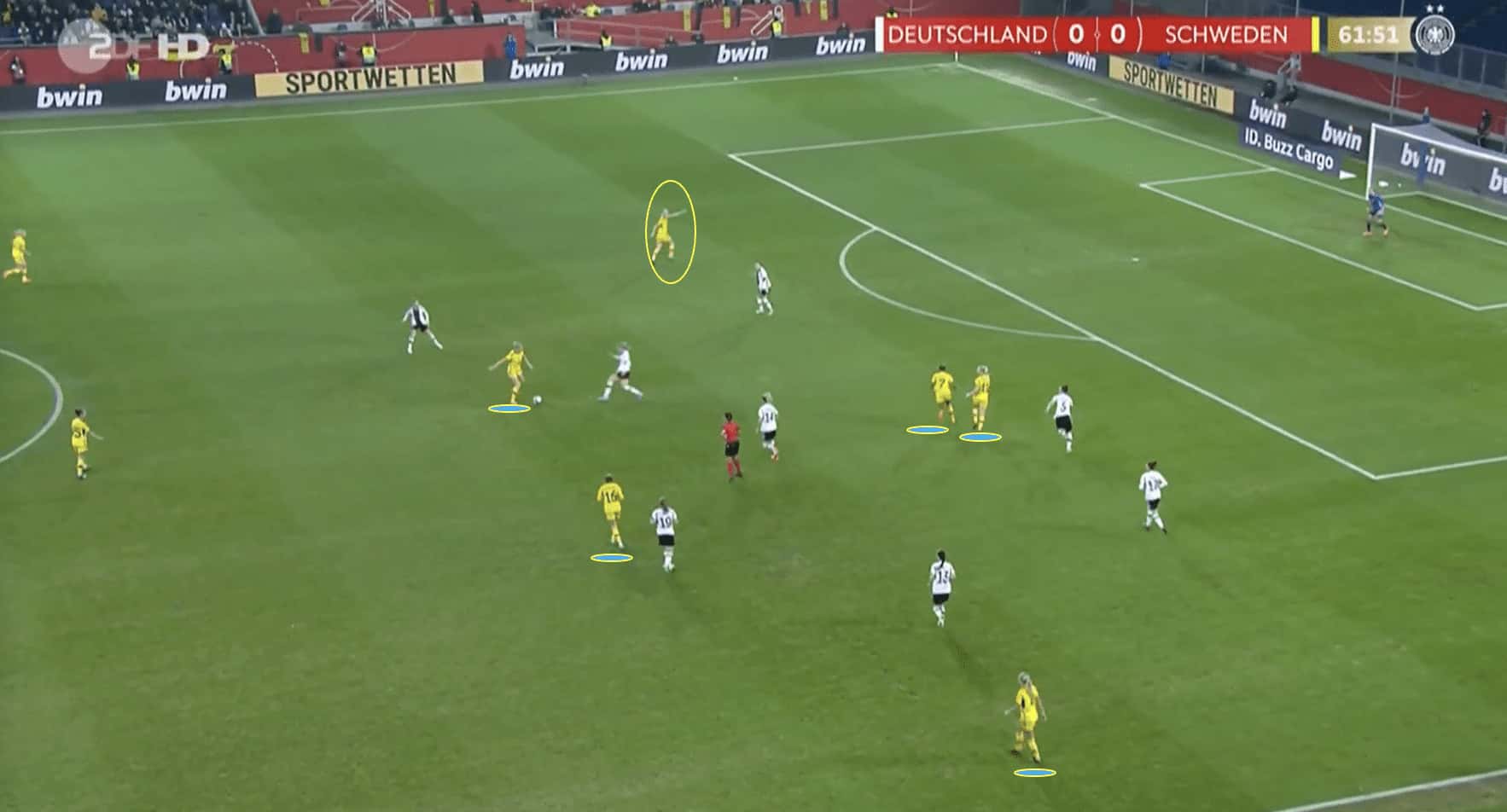
Moreover, when in the attacking phase, Sweden will look to overload one side of the pitch and then execute a switch to the free player on the opposite side. By overloading one side of the pitch, the Swedes can concentrate their players in a specific area, overwhelming the opposition’s defence in that particular zone. This concentration of players can lead to an imbalance in the defence, as they are forced to shift players across to defend against the attacking threat. This, in turn, creates gaps and spaces on the opposite side of the pitch, as we can see above.
Gerhardsson’s team attacked down the right side and created a numerical overload which of course enticed the German defenders over in an attempt to limit the Swedish attack. We can see that Rolfö is free on the left side and one well placed through pass will see her be able to get a shot at goal. This opportunity was created out of Sweden overloading the right side and then quickly switching the play to exploit the weak side.
Defensive Phase
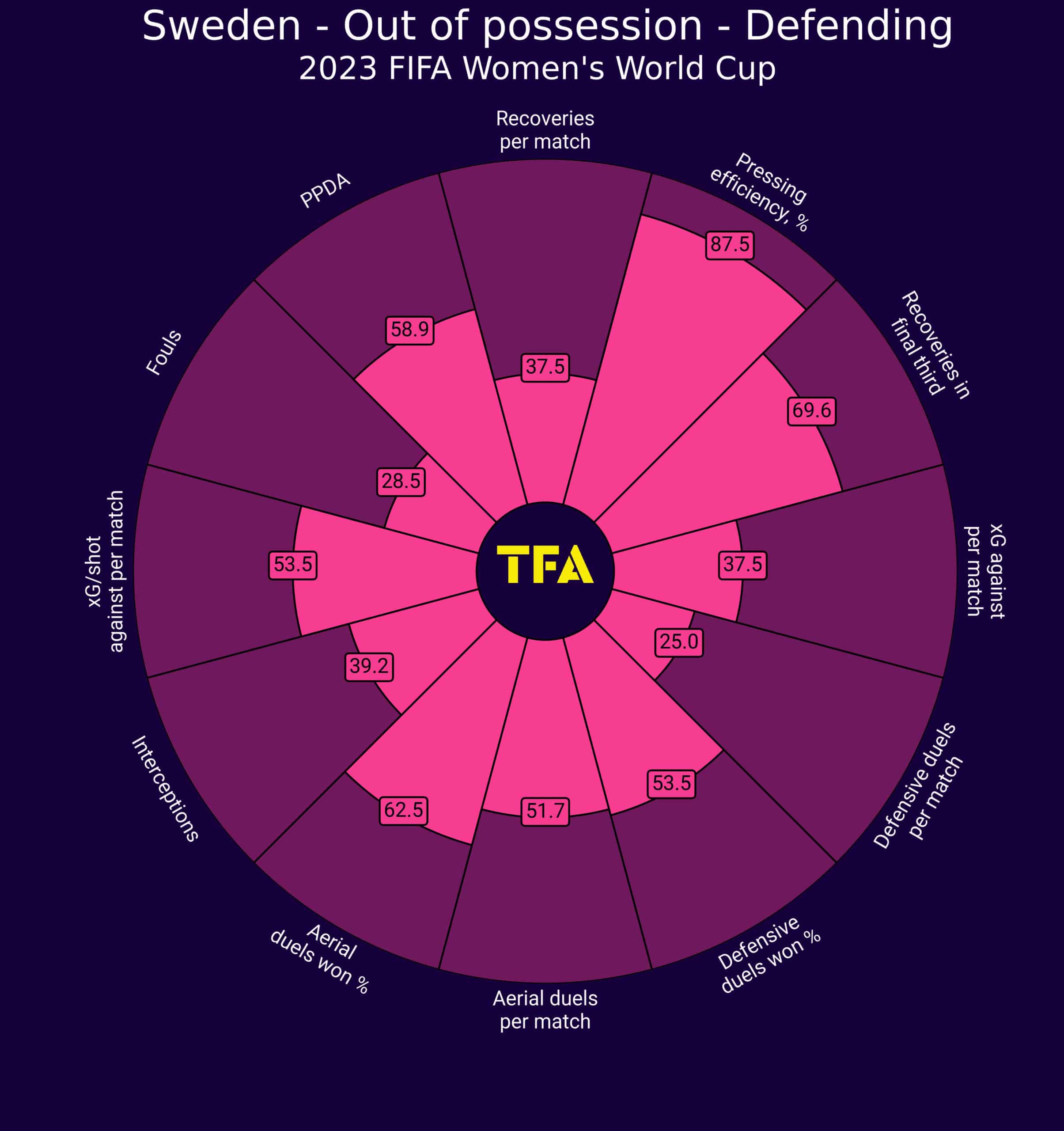
From this data visual, we can see that Sweden will press in order to regain possession higher up the pitch which can be effective and lead to them recovering the ball in the final third. Whilst they don’t engage in a high amount of defensive duels per 90, they do win a good amount of them which means the Swedish team are effective defensively and as we can see, they don’t concede a huge amount of goalscoring opportunities per 90.
Moving on, in this section of the tactical analysis, we will delve into how Sweden set up in the defensive phase. As we know, Sweden have mostly used a 4-2-3-1 over the course of 2023; during the defensive phase, this typically becomes a 4-4-2 shape.
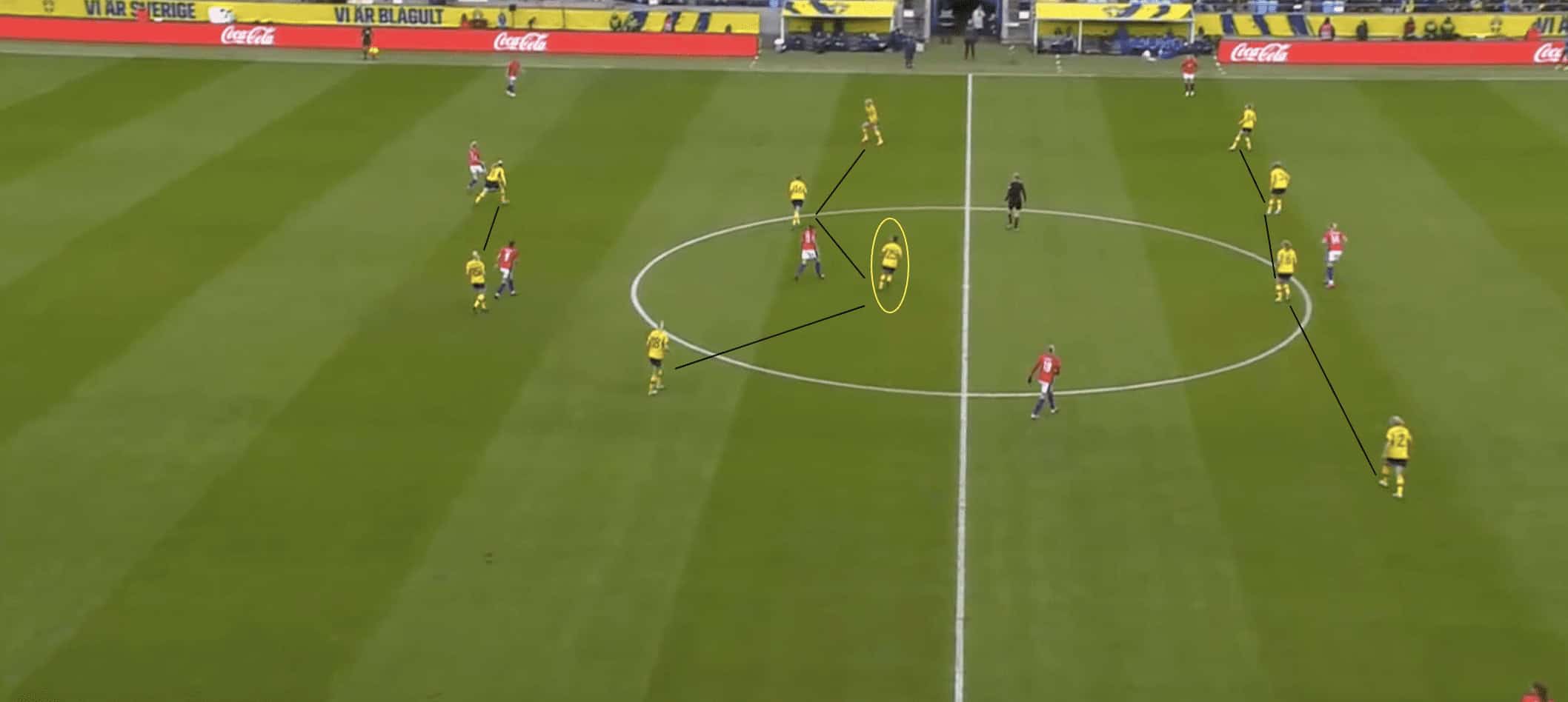
By transitioning to a 4-4-2, the defensive shape of the team immediately becomes more compact. The additional two players in midfield provide extra bodies to defend and deny the opposition space to operate and build up. This compactness makes it harder for the opposition to find gaps and exploit weaknesses in the defensive structure, forcing them to play wide or attempt long-range efforts.
The 4-4-2 defensive shape also helps in numerical superiority. With four midfielders, the team can outnumber the opposing team’s midfielders, denying them passing lanes and pressuring them into making mistakes. This can disrupt the flow of the opposition’s attacks and provide more opportunities for interceptions and regains.

Additionally, on occasions during the defensive phase, one of the midfielders will adopt a freer role in order to sit a little deeper and provide extra protection for the defence as shown above.
This is especially beneficial when the opposition is playing with a number 10 as it allows the Swedish team to directly cut off the passing lane to the player. This makes it very difficult for the opposition if they are looking to play through the lines.
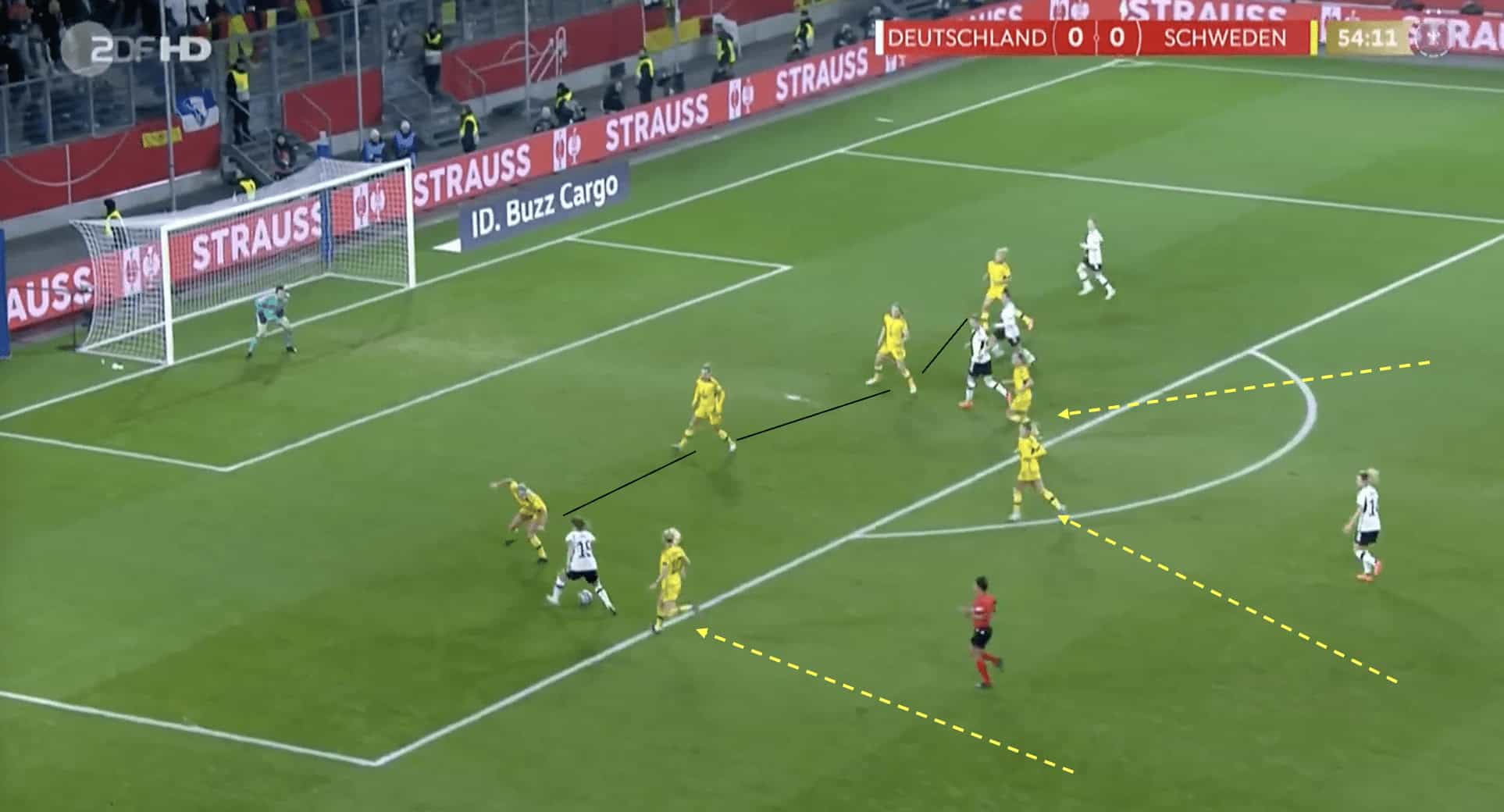
As the opposition builds an attack, and the initial press is beaten, Sweden will fall back into a low block of four defenders as we can observe above. With all four defenders positioned deep into their own penalty area, the team has a higher concentration of players in their defensive third. This numerical superiority helps in winning aerial duels, intercepting passes, and clearing the ball away from dangerous areas.
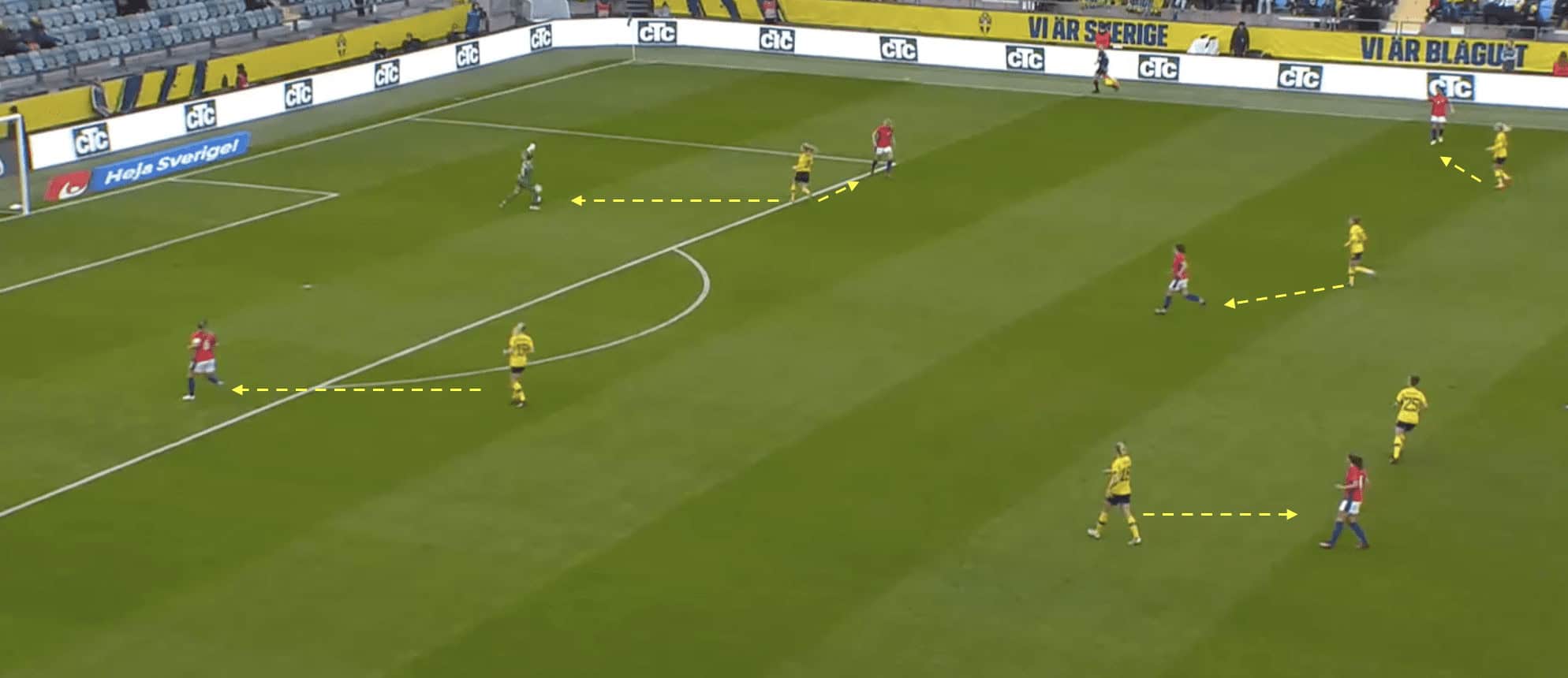
As mentioned previously, Sweden initially look to press reasonably high in order to prevent the opposition from playing out, as shown here. With a PPDA of 8 from their games during the last 12 months, it’s clear that Sweden are not an ultra-high pressing team but will look to try and regain possession as high up the pitch as possible.
This very often disrupts the opposition’s rhythm and coordination. By closing down spaces and applying pressure on the ball carrier, Sweden can disrupt passing lanes and force the opposition to play out quicker than they would like. This can lead to misplaced passes, poor touches, and turnovers, giving the Swedes the chance to exploit these mistakes.
Transitions
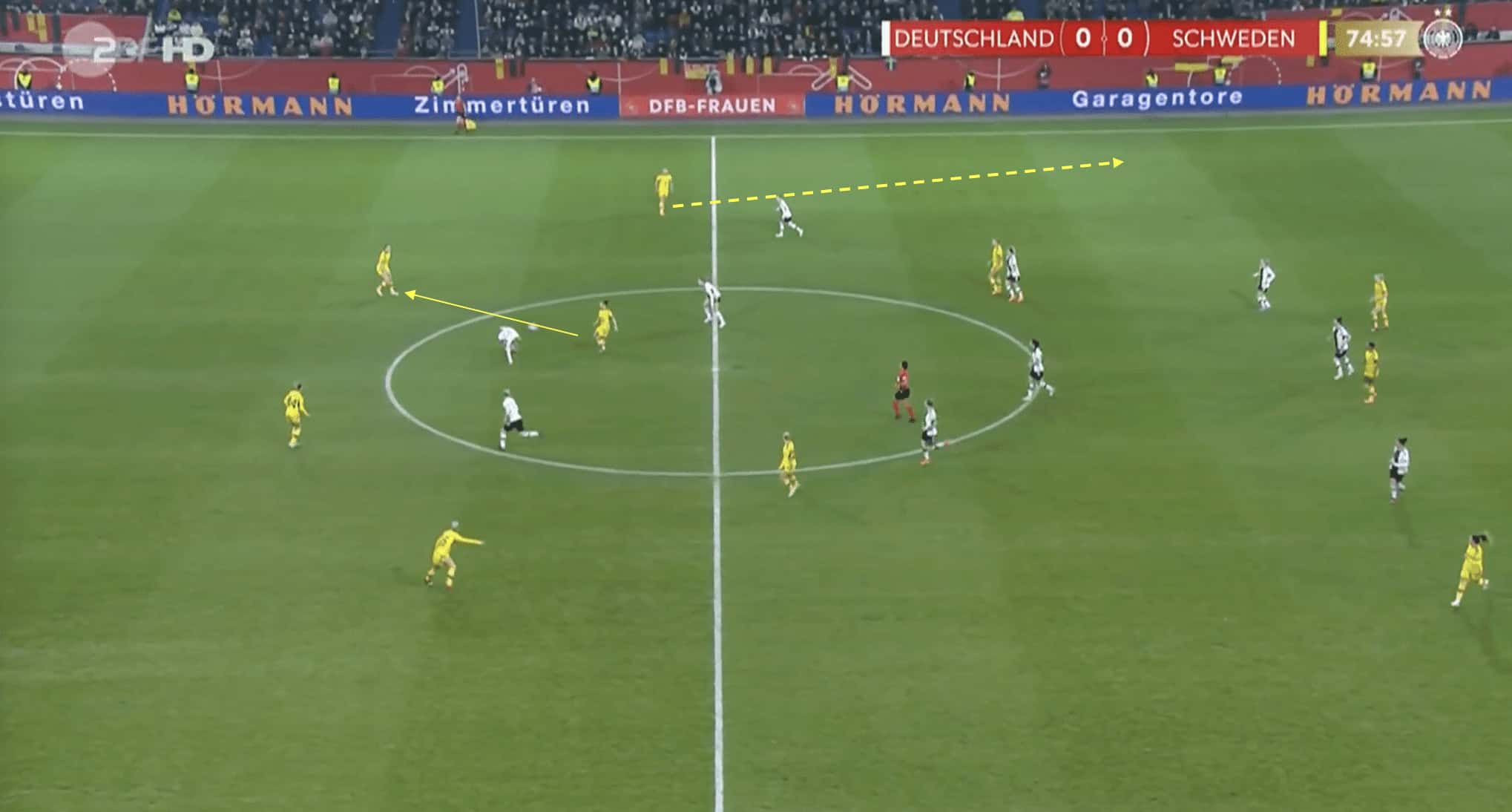
When transitioning from defence to attack, as shown in the image above where Sweden have just regained possession, they will typically look to get the ball into the wide areas as soon as possible.
Utilising the wide areas provides a way to bypass congestion in the central areas of the pitch. In the central zones, the opposition’s defensive structure is typically more compact, making it challenging to penetrate directly through the middle. By quickly shifting the ball out wide, Sweden can access spaces that may be less crowded, allowing for greater opportunities to advance and progress up the field.
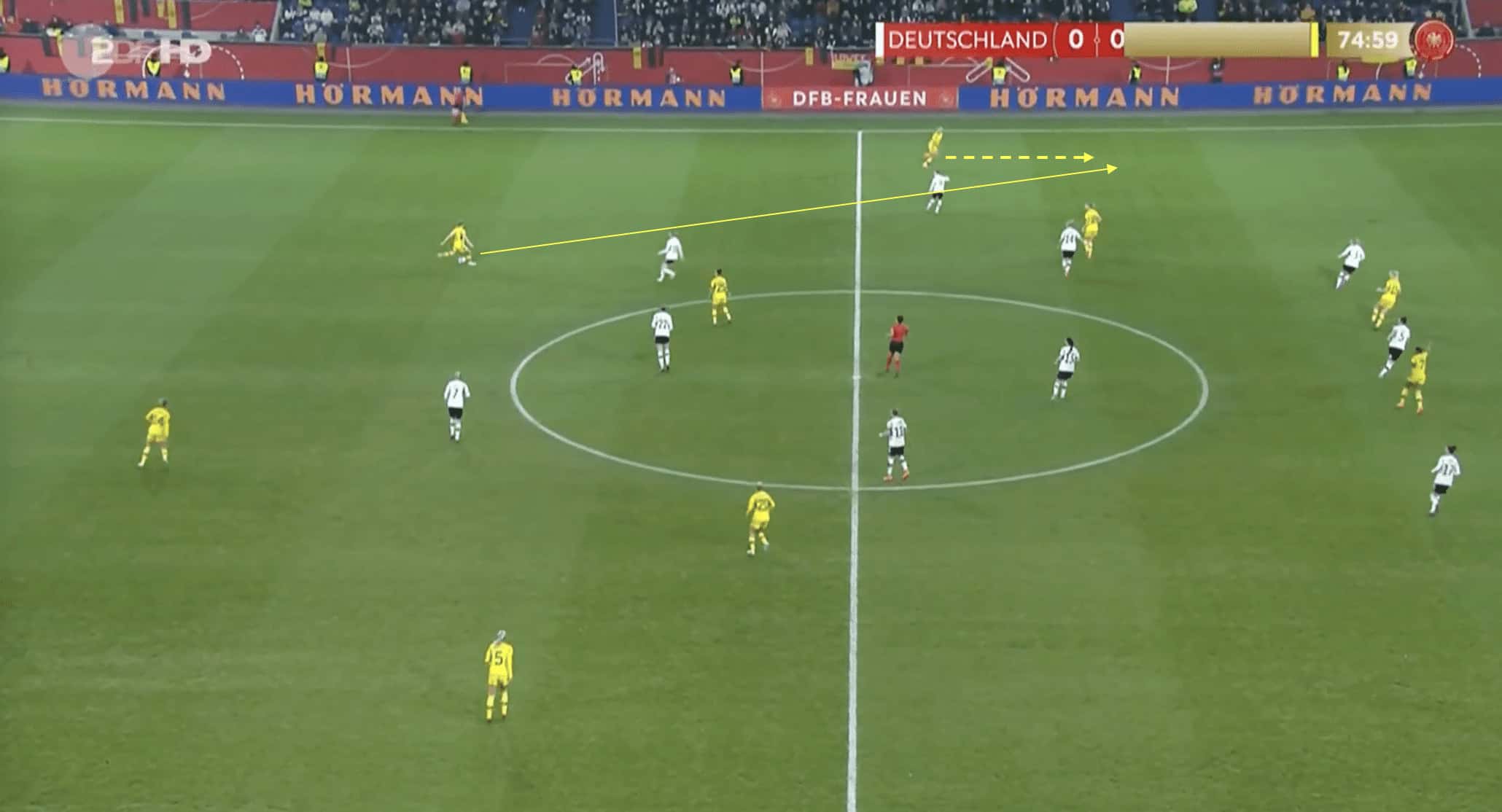
Here, for instance, we can see that after regaining possession, Sweden immediately look to progress the ball out to the left wing. Using the wide areas in the transition from defence to attack helps to create depth and balance in the team’s attacking shape, as it stretches the opposition’s defensive line and forces them to consider the threat from multiple angles. This creates more space and options for the Swedish team to exploit and opens up passing lanes and channels for penetrating through balls or diagonal switches of play.
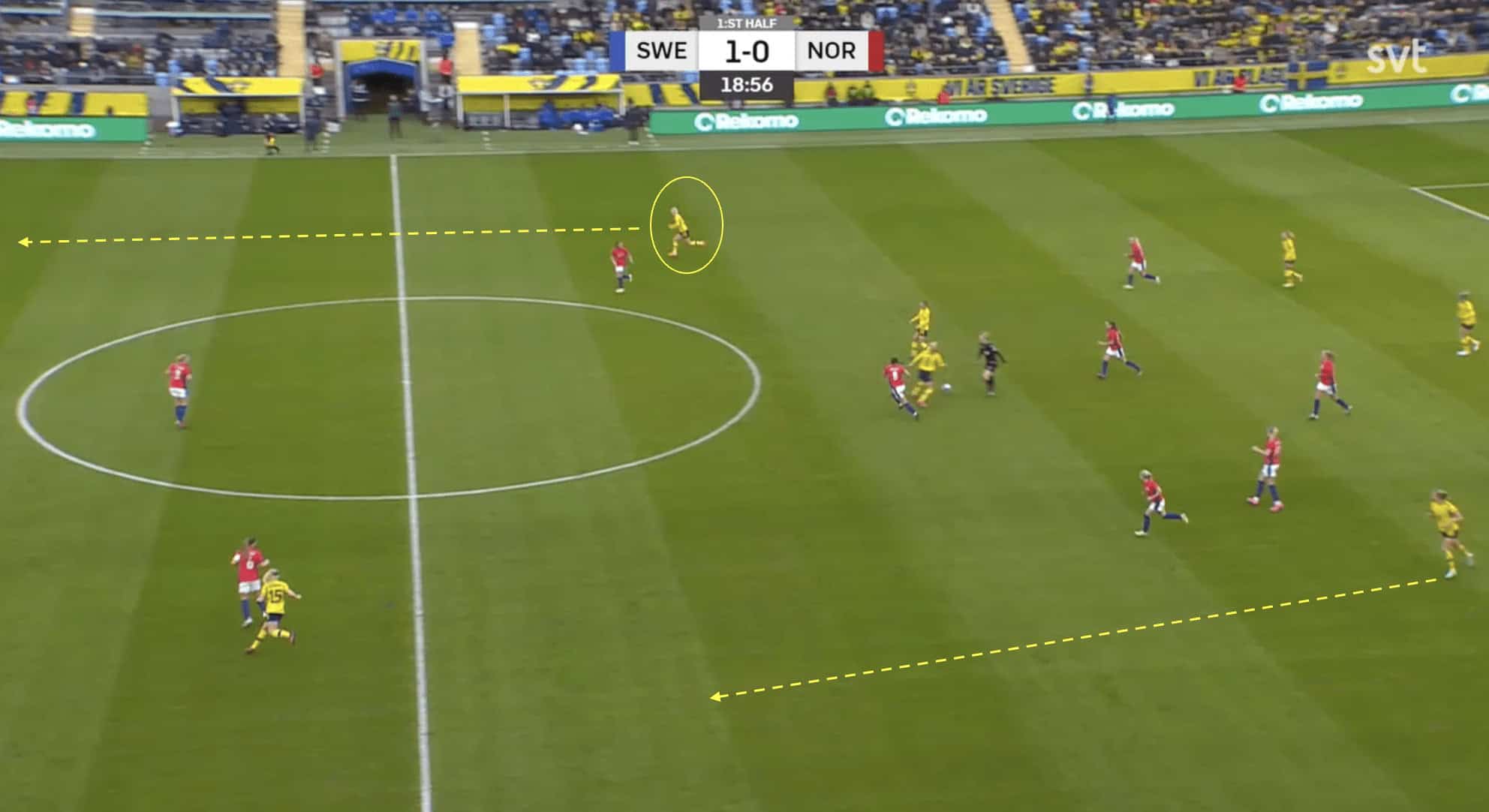
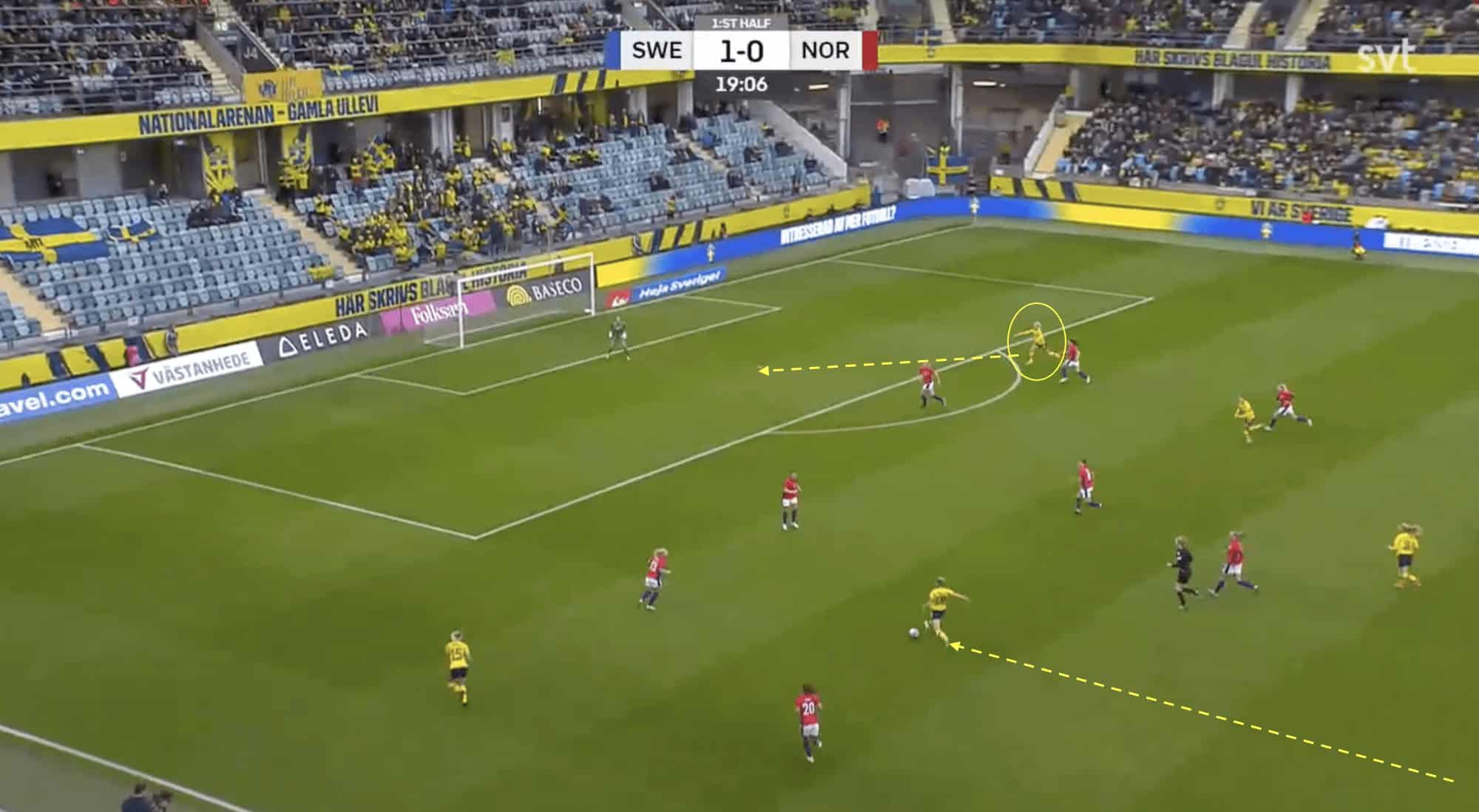
In this next example, we can see a similar scenario play out, as Sweden recover the ball, they look to play it to Rolfö who carries it well into the attacking third. Meanwhile, Jakobsson’s pace means that she is quickly able to reach the opposition penalty area to wait for Rolfö’s incoming cross.
The wide players are absolutely key for Sweden when transitioning from defence to attack. Their wing play can be a potent attacking weapon, as it puts direct pressure on the opposing defence and provides opportunities to isolate and exploit individual match-ups.
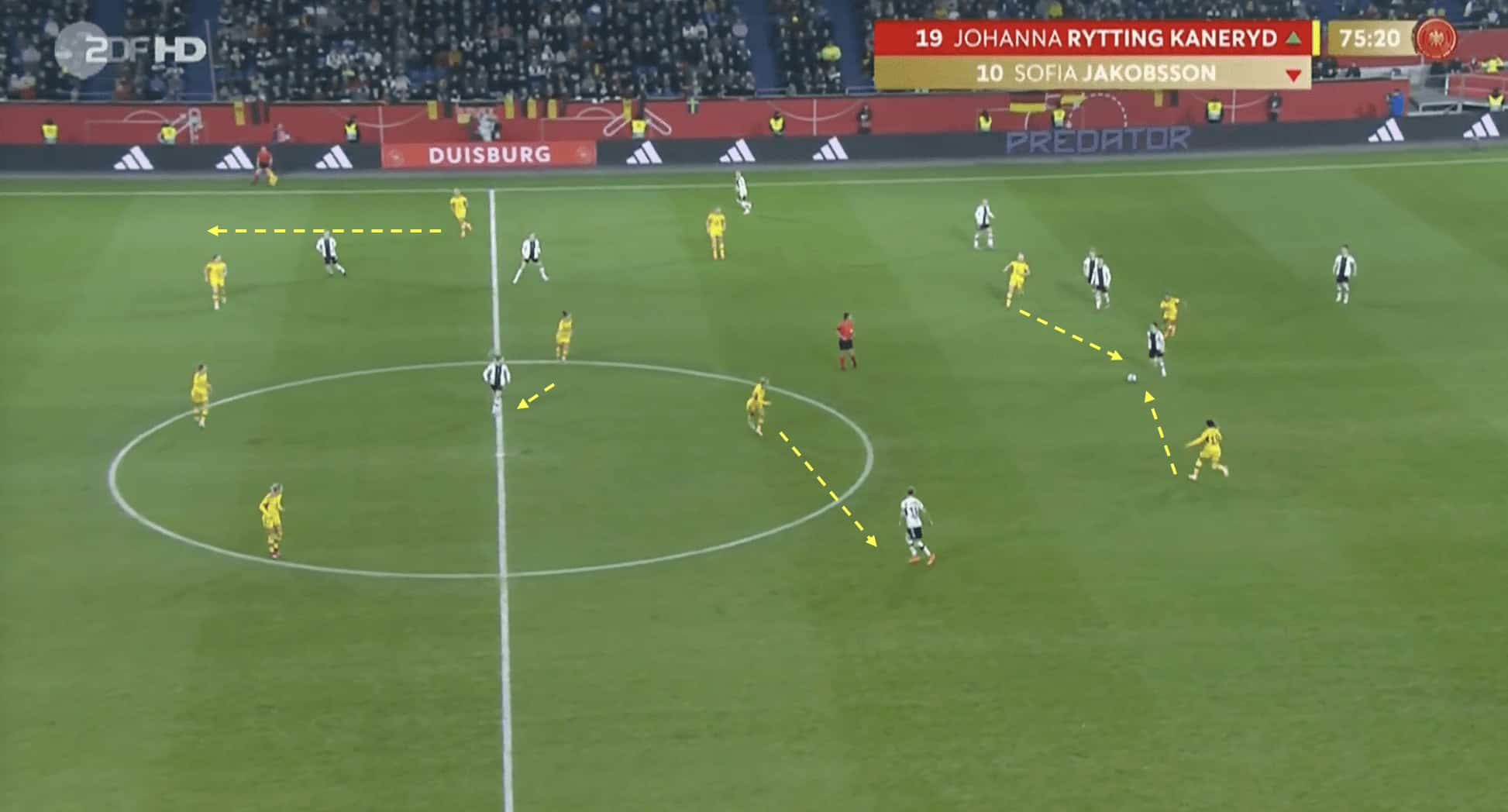
When transitioning from attack to defence, Sweden look to put pressure on their opponents instantly, especially when they have lost possession in the attacking third. By applying immediate pressure, the team increases the chances of regaining possession in dangerous areas of the pitch, preventing the opposition from launching a quick counterattack and maintaining control of the game.
However, it is worth noting that should the opposition be able to play their way through the initial counterpress, Sweden will then usually fall back into a compact low block and look to limit the opposition’s scoring chances.
Attackers
The forward line for Sweden is incredibly talented, as mentioned previously Rolfö will likely play an integral role for Gerhardsson’s team. Typically a winger, she has spent most of the season deployed as a left-back for Barcelona so it will be interesting to see her given more freedom in an attacking role, although she still contributed six goals and four assists for her club this season. Blackstenius has enjoyed a good season for Arsenal and fellow teammate Lina Hurtig offers an excellent option from the Bench for Gerhardsson.
With Sofia Jakobsson who is vastly experienced looking like she will play on the right flank, Sweden have a great opportunity to look to counterattack due to the pace she possesses. Additionally, whilst Madelen Janogy and Rebecka Blomqvist are less likely to be in the starting XI, they are both experienced internationals that complete a very talented group of forward players for this Sweden team.
Midfielders
Experience is a word that sums up this Sweden side and that is very evident throughout the midfield. Caroline Seger has been ever present for the national team since her debut in 2005; much like her appearances at the Euros, it is likely that she will be limited to coming off the bench to provide that extra guidance for Sweden to see out the games to ensure a victory.
Johanna Rytting Kaneryd is a great player to be able to bring off the bench and while she has struggled for minutes at Chelsea this season, she is incredibly creative and is capable of changing a game with her vision and ability on the ball. Elin Rubensson has enjoyed a good start to the season with BK Häcken, having won over 70% of her defensive duels so far, she will be able to provide a screen for the back four as the more defensively-minded midfielder.
Hanna Bennison is the youngest midfielder in the squad and is widely touted as being one of the best young midfielders to watch. Having already racked up 30 appearances at international level, she is also very well-versed in what is expected of her at this level. Finally, Kosovare Asllani acting as a number 10 suits her skillset very well and allows her to drift into pockets of space which she does expertly and is able to provide the link between defence and attack.
Defenders
Hanna Lundkvist and Anna Sandberg are two talented young defenders but it is difficult to say whether they will receive any game time or not. Magdalena Eriksson is one of the best defenders in women’s football, this season with Chelsea saw Eriksson win 67.2% of her aerial duels per 90 and 59.3% of her defensive duels. She is also very good on the ball and is able to play accurate long passes should Sweden require.
One of Linda Sembrant and Amanda Ilstedt will be Eriksson’s partner in central defence, both players are very astute defenders so Gerhardsson will face a difficult choice between the pair. Nathalie Björn and Jonna Andersson will most likely be the starting full-backs and will be charged with providing plenty of support to the Sweden attacks as well as their obvious defensive duties.
Key Player
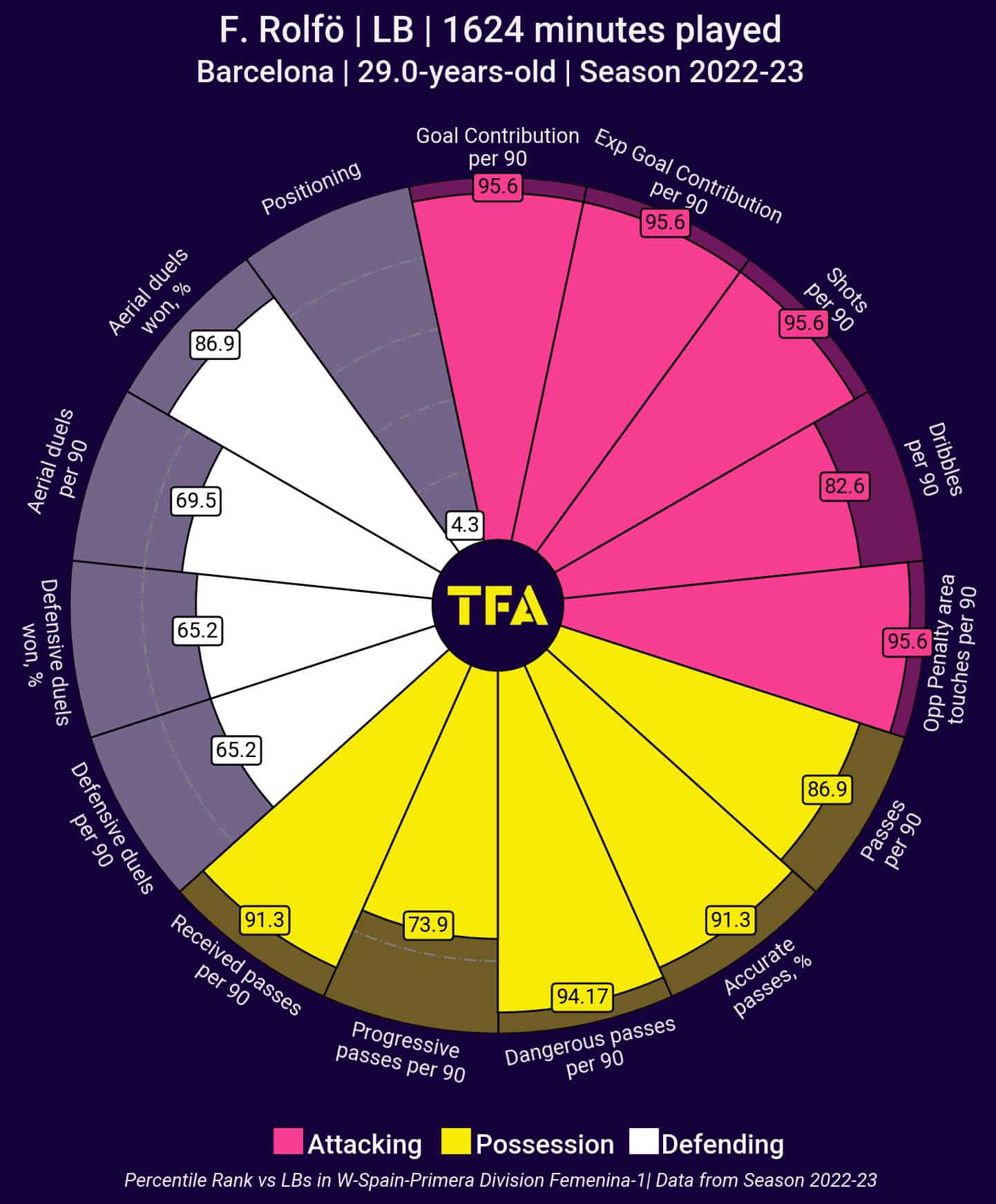
It’s difficult to pick who is Sweden’s key player as they possess such a strong squad, based on recent performances, though, Fridolina Rolfö is certainly in the running to be their standout player.
As mentioned earlier in this analysis, Rolfö is a winger but has been used as a left-back for most of this season at Barcelona. From the data visual above, we can see how the Swede compares to fellow left-backs in the Spanish top flight.
Rolfö is very creative in possession and is able to play a vast amount of accurate and progressive passes which are able to open up goalscoring opportunities for teammates. She is comfortable carrying the ball which is very useful when Sweden are transitioning from defence to attack. Rolfö is a great team player and will work well defensively. Moreover, the added time playing as a defender this season will have likely improved her defensive skills which could be useful during Sweden’s World Cup campaign.
Tournament Prediction
With many of their players potentially playing in their final international tournament, there is a sense of now or never for Sweden. They find themselves in Group G alongside South Africa, Italy and Argentina. This is a group that Gerhardsson’s team should be able to top and move into the knockout stage.
If they do in fact move beyond the group stage, the winner of Group G will play the runner-up of Group E which consists of the USA, The Netherlands, Portugal and Vietnam. The best guess is that Sweden would likely face The Netherlands in the knockout round which presents a tough game and one that the Swedes will certainly have to work hard to win. Following the knockout round, the pathway to the final would see Sweden potentially face the likes of Spain, Norway, or Australia.
This Sweden team has some incredibly talented players that work so well together in a team but can also produce moments of individual brilliance which can change the course of a game. So whilst it is important not to write this Sweden team off, it’s difficult to see them going beyond the quarter-finals due to the quality of the opposition teams they could face.





Comments